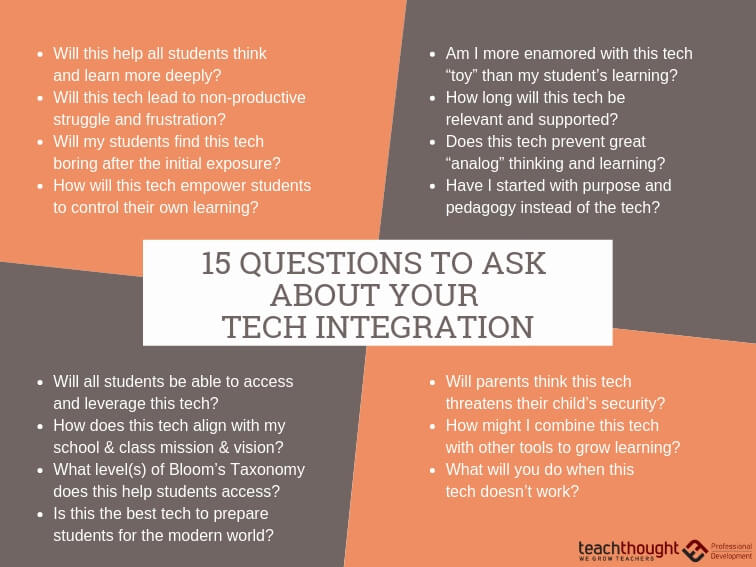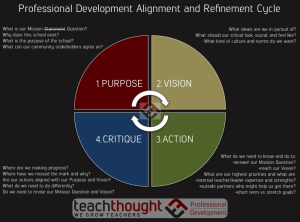

by Drew Perkins, Director of TeachThought PD
Recently over Christmas–and the corresponding break from school for my daughters–come and go I was reminded of the fun that technology toys can provide.
I was given a Google Home device and it’s entertaining for my daughters to ask it to make funny sounds, play silly games, set timers, and even ask it for help on their homework. For me, it’s a great way to start my day asking it to tell me the news or play music throughout the house.
The flip-side of that techno-circus is the trap of finding yourselves engaging with screens and those tech-toys for hours on end and missing out on more analog-like experiences. Just like at home, there are so many great reasons for integrating technology into our schools and classrooms but we’re wise to keep our focus by asking whether we’re just playing with the edtech toys in our classrooms or truly using those edtech tools to leverage and grow student thinking and learning.
When Should You Integrate Technology?
Perhaps the best answer to this question might be, whenever it helps. That might seem ridiculously simplistic but consider the alternative…when it doesn’t help. The complexity of integrating technology begs us to identify the positives and negatives, weigh those, and be sure we’re focused on what’s best for students. With that in mind, here are 15 questions to help you think about your technology integration.
Obviously, this is by no means exhaustive, in fact, I’d love to hear questions you think would be important to add to this list.
1. Will this help all students think and learn more deeply?
Not only should the technology tool you’re considering help students think and learn more deeply, but it should also help you differentiate instruction to help each and every student access that thinking and learning rather than just some students. Does yours? How might your use of technology leverage the 6 Elements of DI?
2. Will this tech lead to non-productive struggle and frustration?
If the technology is glitchy and problematic or just too difficult for the students and you to navigate you run the risk of running into a dead-end. We want students to struggle productively and frustration can be ok if the work interests them but we don’t want to lose them because the tool keeps halting their progress.
3. Will my students find this tech boring after the initial exposure?
Beware that myth about how great technology is at engaging students. Yes, new technology can indeed grab the attention of all of us but how quickly will that wear off? Any of us with small children can tell you it’s not uncommon for kids to unwrap those Christmas gift tech toys only to put them down in favor of a cardboard box. If you’re relying on technology as a classroom management tool you may quickly find yourself in trouble.
4. How will this tech empower students to control their own learning?
One of the goals of great learning environments should always be the empowerment of students. Does the technology help them ask and pursue their beautiful questions or is it limiting students? Turning a worksheet into a Google Doc isn’t empowering students unless the goal is to help them become more facile with Google Docs and even so aren’t there better ways to do that?
5. Is this a toy or a tool?
Few things raise questions in my head more quickly than seeing a teacher who can’t wait to show me their latest tech gadget. Don’t get me wrong, I find them fascinating and love the passion but just because a tool has captured your imagination doesn’t mean it necessarily has a place in your classroom or school. It might indeed be a great way to grow learning but starting your lesson planning by thinking, “How can I integrate this neat new tech toy?” more often leads you down a stray path.
6. How long will this tech be relevant and supported?
The speed at which technology evolves is staggering and while it’s not likely that your devices or tools will be outdated in a lesson or even a school year there are instances where resources go away unexpectedly. More likely is not having the tech support in the event of problems or needed updates either internally or externally. To add to that, some districts block web traffic that you might have counted on.
Better to be sure before starting than have to devise a workaround.
7. Does this tech prevent great ‘analog’ thinking and learning?
There are times when technology actually gets in the way of great communication, collaboration, and creativity. For example, we love the question-storming process of the Question Formulation Technique. While this can certainly be done digitally using Google Docs or something similar it would be hard to reproduce the synergy that occurs when a group is huddled around a large chart paper or whiteboard with markers building questions from the questions and thinking of others. Even in the most technology-rich settings, it’s often better to go analog.
8. Have I started with purpose and pedagogy instead of the tech?
This is related to #5 above but not exactly the same. Sometimes teachers are directed to use a certain tech tool more often, or perhaps they’ve just learned about it in a recent faculty meeting or workshop. In this scenario we often find teachers trying to figure out a way to use that tool without first considering their purpose and it usually feels like trying to fit a circle into a square.
What do we want students to think about and learn and what tools can better help us do that? As TeachThought PD facilitator Allan Carrington shows us with the Padagogy Wheel, It’s Not About The Apps, It’s About The Pedagogy.
9. Will all students be able to access and leverage this tech?
Do you have any students whose struggles to use certain technology tools might hinder their learning? That doesn’t necessarily mean you shouldn’t use that particular tool but are there similar tools that might be more accessible? Or are there workarounds or supports you might consider to help them access the learning process? How might you make accommodations that don’t leave students behind?
10. How does this tech align with my school & class mission & vision?
Admittedly most school Mission and Vision statements are enigmatic and ambiguous but they shouldn’t be. Have you clarified a mission/purpose and vision for your classes? This can be a great way to stay on point and any lessons, units, including the use of technology should be aligned to help bring that mission/vision to life.

11. What level(s) of Bloom’s Taxonomy does this help students access?
The simplicity of Bloom’s Taxonomy can be helpful when thinking through lesson planning. Is your tech tool going to be solely focused on information gathering or will it be used to help students create? While there are times when using technology for lower-level Bloom’s tasks is appropriate we’re missing wonderful opportunities if we remain stuck there.
12. Is this the best tech to prepare students for the modern world?
21st Century Skills, NextGen Skills, call them what you like but we have to be focused on preparing students for the modern world. Whenever possible we want to get students engaged with technology that is closer to the cutting edge. Perhaps more importantly we want to be sure we’re facilitating in ways that push students to cognitively travel the landscape of the modern world.
13. Will parents think this tech threatens their child’s security?
Perceptions can become reality and as a parent, I’m leery of the threats that can gain access to my children via technology. Be sure that your use of technology is indeed safe for your students but it’s smart to get out ahead of the messaging with parents. I appreciate when the teachers of my daughters communicate well ahead of time and if there’s a tech tool that might cause apprehension from parents giving them a chance to investigate in advance can be very helpful. This is not a case where the saying “It’s easier to ask forgiveness than it is to get permission” holds true.
14. How might I combine this tech with other tools to grow learning?
Sometimes we get so focused on new technology that we don’t consider how we might creatively combine it with other tools (digital and analog) to better grow learning. This often becomes more evident after we use that technology a time or two. Google the tool or ask on Twitter or other social media and you might benefit from others who have more experience with that technology and have some great uses you haven’t considered.
15. What will you do when this tech doesn’t work?
To use another famous quote, “The best-laid plans of mice and men often go awry.” Be prepared for the inevitability of tech glitches because we all know it’s going to happen. Do you know the technology well enough to navigate through the glitches? Will you be able to continue with the learning you’d planned without the technology? Are there alternate activities and work your students can do, perhaps other parts of a project if you’re engaged in Project-Based Learning, and then return to the planned work later? Don’t be left scrambling with a class in disarray because the wifi went down or the website you’d planned to use is offline.
Your guiding questions?
The ever-changing terrain of integrating technology presents opportunities and challenges that can feel daunting but continually asking yourself important questions like these can be your best guide. What other questions would you add to this list?
Are You Using Technology Because You Can Or Because You Should?; 15 Questions To Ask About Tech Integration In Your Classroom